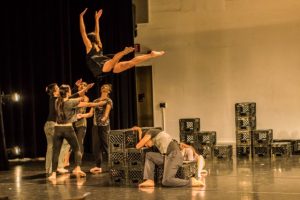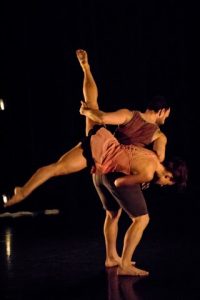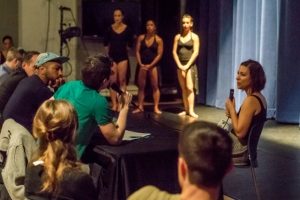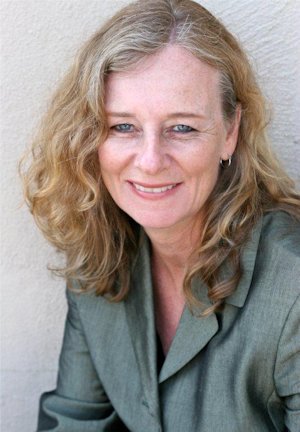When Dance Makers Test Work & Compete for Prizes, Everyone Wins
What is a perfect day for a serious choreographer? Try critical feedback from top dance artists, an adoring audience, and bragging rights. Winning a big cash prize is groovy too. When established dance makers and those just discovering their choreographic voice test their work with professional support, everybody wins.
CHOREOLab2015
Cheers to the La Jolla Music Society and producers of CHOREOLab that gives San Diego dance makers a chance to present work to a panel of leading choreographers, dancers, artistic directors, and dance aficionados.

Caryn Glass makes a running leap in “SPACES,” by Ami Ipapo. Images: Matthew Fernie
In conjunction with its presentation of Wendy Whelan/Restless Creature, CHOREOLab2015 gave five San Diego choreographers the opportunity to mingle with the ballet superstar and present work to the men who collaborate and dance duets with her – choreographers Kyle Abraham, Brian Brooks, Joshua Beamish, and Alejandro Cerrudo. There was also a small stipend for dancers and tickets to Whelan’s show the following night.
Participants included: Blythe Barton, Geoffrey Gonzalez, Ami Ipapo, Melissa Nunn, and Elyssa Dru Rosenberg. Marcus Overton moderated. After an initial performance on Jan. 29, at ENS 200, the dance studio theater at San Diego State University, they got friendly feedback from the panel and 20 minutes to plan a performance do-over.
Dancers and choreographers are used to criticism and must have thick skin. Adrenaline was pumping at this event. With so much talent in the small space, it felt like dance-maker Disneyland. Still, the mood was upbeat, more excitement than nerves. The dialogue was thoughtful and constructive, and one cannot overstate the artistic value of the event, for both the panelists and those showing work. The thrill for the audience was witnessing the choreographic process in real time.
“Nice work, the cinematic style is strong,” said Brooks in response to Ms. Ipapo’s group piece “S P A C E S. “I like the doorway zoom effect. The bursting and running could be more extreme. Imagine the piece without the sound score. “
There was discussion about how to “highlight caverns” and achieve more contrast between the functional and narrative, contrasting dancers that slide and build structures with milk crates against a tumultuous duet.
After viewing Barton’s quartet, “A Darkened Plume,” Beamish noted revolving structures and the warm and cool costumes for the two couples.

Bradley Lundberg and Cara Steen partner in “A Darkened Plume,” by Blythe Barton.
“Your intention was very clear,” Beamish said, “but I wasn’t sure where to watch. Perhaps use lighting to direct me and enhance things.” Seated at the opposite end of the table, Cerrudo said he liked that Barton let the viewer decide where to look. “I felt like I was missing some beautiful things, but that is okay,” Cerrudo said. “Try changing the dynamics, stop for three seconds.” Abraham liked how two couples moved up and down stage and the rocky lift when a dancer slipped off her partner’s shoulder. “I dug that,” Abraham said, “and like Alejandro, I think the dangerous lift was exciting and a big shift. You were not afraid to give us lots of layers and levels.”
Brooks commented on Barton’s gorgeous partnering and counterpoint.
“There was a sweeping quality that felt like calligraphy,” he said. “I like your sense of centrifugal force and not stopping.” His statement triggered laughter from Ms. Whelan in the bleacher seats, who is keenly aware of Brook’s dance aesthetic and approach to partnering.
Abraham asked about the internal focus and having a “unison section start at the beat” in “Presence,” an ensemble piece by Melissa Nunn and danced by students from SDSU. Brooks said the dance had the power to guide our sense of time.
“I was pulled into a time warp,” Brooks said. “How does that happen? This was successful as a collage, and I enjoyed the solo – by using distance, you set up a dramatic shift for us.”
Beamish also liked the final solo, a short aggressive burst from a tall muscular woman, and how dancers watched others dance. He encouraged more resistance and suspension. Cerrudo asked if the work had been edited because there were so many ideas that needed further exploration. Nunn, a well-known SDSU professor of 30 years, said she collaborated with students and sound designer Kristopher Apple. Dancers whisper about sacrifice and cost and being physically present at the end of the work.
“We composed text about how we are present, and that we must invest time and commit to things, and that costs us,” she said. “We have to decide what to give up, so we can be physically present.”
After feedback and a 20 minute break, the participants performed again. More fun than a parlor game, viewers carefully watched for slight changes in focus, phrasing and staging. There were compelling transformations, a testament to the talent of both the presenters and panel.
In the initial performance, Rosenberg, a choreographer known for Isadora Duncan reconstructions, set her work “Trio” to a pulsing score (Code Name Vivaldi, by the Piano Guys). The four men on the panel challenged her to steer in several new directions. “Maybe you should do an opposite of the music,” said Cerrudo, “because you had fun with the music, but to me it was too much fun.” Rosenberg took it all in and smiled.

Elyssa Dru Rosenberg describes her dance “Trio” for the panel and audience.
The second time, Rosenberg’s work was set to a different score and edited costumes. The three women of the trio were no longer cabaret dancers. Their sequined half skirts were gone, and their intertwined arms and twisting suggested stronger characters, such as the three fates. Rosenberg alluded to the mythical sisters in the earlier discussion, and with some tweaks, that intention was realized. The dancers seemed less human and more dangerous, and the dance had a darker life and death tone in the second showing.
Geoffrey Gonzalez presented a solo from a larger work, “Infinitus,” and it was danced by his wife, Ariana Gonzalez. (The two recently married. City Ballet of San Diego fans know her as Ariana Samuelsson, a lovely ballet dancer and daughter of Elizabeth and Steven Wistrich who run the company).
“I’d be curious to see if you let some of the movement have more surrender, and play more with vulnerability,” said Abraham. “The développé is beautiful, so think of the importance of that leg gesture.” He was referring to the movement when the working leg draws the knee up the supporting leg and then extends slowly. Cerrudo said, “Choose where to look. I want to see the solo as if we are not here, that she is not dancing for us, but for herself. “
Beamish added, “I would love to see more of your beautiful facility… close the ribcage more and dance from the pelvis,” he said. He also suggested exaggerating shifts in direction and staying there a bit longer.
The second time around, Ms. Gonzalez did all that. She pulled more surrender and lament into her body as if we were not there. She appeared more vulnerable and the dance was more engaging than before. Bravo to all the artists who shared their craft in this unique choreographic experience.
For more information on CHOREOLab, contact Jonathan Piper, Ed. Mgr. at [email protected].
SDSU Choreographer Residency
Choreography under a microscope continues at San Diego State with Israeli choreographer Emanuel Gat in residence this week. http://www.emanuelgatdance.com/emanuel-gat/
He’s working with university students Feb. 2 through Feb. 6, and that culminates with a showing of the work in the dance theater studio (ENS 200) on Feb. 6 at 7:30 pm.
Gat was born in Israel in 1969 and has set work for dance companies around the world, such as: The Paris Opera Ballet, The Royal Swedish Ballet, and Cedar Lake, among others. Dance professor and coordinator Joe Alter says the choreographic process is open for observation, discussion, and feedback. He invites dancers and performing arts supporters to attend daily from 4:30 to 8 pm. Seating is limited and it is free.
http://music.sdsu.edu/index.php/about/map
San Diego Young Choreographers Showcase and Prize 2015
Dance maker Disneyland continues as choreographers compete for prize money and bold notations on their dance resumes this month. A panel of judges and the audience will decide the winners of the annual San Diego Young Choreographers Showcase and Prize, at 8 pm., on Feb. 21, 2015. A reception and award ceremony follows.
Dance makers include: Julio Catano, Ian Isles, Alyssa Junious, Aurora Lagattuta & Kate Vigmostad, Celest Lanuza, Sulijah Learmont, Emily Miller, Paul Mota, Jaime Nixon, Edrian Pangilinan, and Ariana Siegel. http://www.sandiegodancetheater.org/ChoreographersPrizeChoreographers.html
Categories include most original choreography and most compelling performance by and single dancer, and best performance by a group of three or more dancers.
Coronado Performing Arts Center. 650 D Avenue. Coronado, CA 92118. Tickets $20.
http://www.sandiegodancetheater.org/ChoreographersPrize.html

Kris Eitland covers dance and theater for Sandiegostory.com and freelances for other publications, including the Union Tribune and Dance Teacher Magazine. She grew up performing many dance styles and continued intensive modern dance and choreography at the Univ. of Minnesota, Duluth, and San Diego State Univ. She also holds a journalism degree from SDSU. Her career includes stints in commercial and public radio news production.
Eitland has won numerous Excellence in Journalism awards for criticism and reporting from the San Diego Press Club. She has served on the Press Club board since 2011 and is a past president. She is a co-founder of Sandiegostory.com. She has a passion for the arts, throwing parties with dancing and singing, and cruising the Pacific in her family’s vintage trawler. She trains dogs, skis, and loves seasonal trips to her home state of Minnesota.
